Each quarter, we invite our state agency sponsors to contribute news from their agencies. See below for the latest from DEQ, DWR, and VIMS!
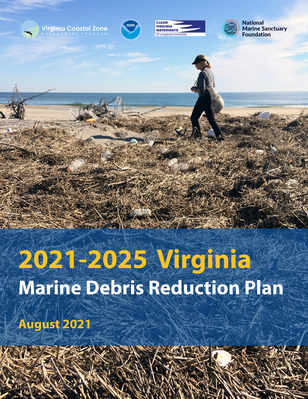
Tackling the Problem of Plastics in our Ocean
Submitted by Virginia Witmer, Virginia CZM Program, DEQ
Virginia Marine Debris Reduction Plan
The Virginia Coastal Zone Management (CZM) Program and its partner Clean Virginia Waterways of Longwood University (CVW), released the 2021-2025 Virginia Marine Debris Reduction Plan with strategic, definitive actions to reduce debris in Virginia’s coastal waterways and the Atlantic Ocean. Harmful sources of plastic pollution are all too common along Virginia’s shorelines and become marine debris that ultimately flows into the ocean—including bottles, balloons, plastic bags, cigarette butts, and food containers.
The plan, funded through grants from the National Oceanic and Atmospheric Administration (NOAA), sets out major goals to reduce consumer debris, derelict fishing gear, microplastics and abandoned/derelict vessels. The plan was initially published by Virginia CZM in 2014, and was the first such plan on the east coast.
The Virginia plan focuses on changing the behaviors that often cause litter. Virginia CZM and its partners, including local governments, will explore options for additional litter prevention behavior change campaigns. In addition to prevention, the plan outlines the need for more research, monitoring, removal of debris and litter, increased infrastructure and proper disposal options, as well as new policies and laws.
Submitted by Virginia Witmer, Virginia CZM Program, DEQ
Virginia Marine Debris Reduction Plan
The Virginia Coastal Zone Management (CZM) Program and its partner Clean Virginia Waterways of Longwood University (CVW), released the 2021-2025 Virginia Marine Debris Reduction Plan with strategic, definitive actions to reduce debris in Virginia’s coastal waterways and the Atlantic Ocean. Harmful sources of plastic pollution are all too common along Virginia’s shorelines and become marine debris that ultimately flows into the ocean—including bottles, balloons, plastic bags, cigarette butts, and food containers.
The plan, funded through grants from the National Oceanic and Atmospheric Administration (NOAA), sets out major goals to reduce consumer debris, derelict fishing gear, microplastics and abandoned/derelict vessels. The plan was initially published by Virginia CZM in 2014, and was the first such plan on the east coast.
The Virginia plan focuses on changing the behaviors that often cause litter. Virginia CZM and its partners, including local governments, will explore options for additional litter prevention behavior change campaigns. In addition to prevention, the plan outlines the need for more research, monitoring, removal of debris and litter, increased infrastructure and proper disposal options, as well as new policies and laws.
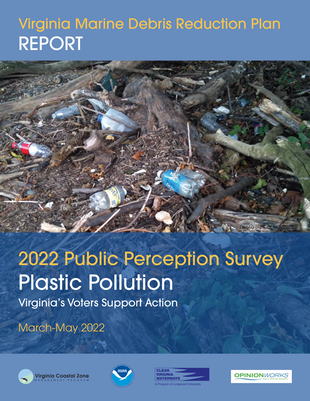
New Survey Shows Virginia Voters Concerned About Plastic Pollution
Virginia voters are concerned about plastic getting into our rivers, bays and ocean, and they support action to decrease littered plastic bags, bottles, cups, food containers and other plastic items according to a new statewide survey released in September 2022 by the Virginia CZM Program, CVW and OpinionWorks.
The survey explored the perceptions and attitudes of Virginia’s voters about several problems, and measured voters’ support for policies that have been adopted in other states. As a follow-up, OpinionWorks invited a cross-section of voters into deeper, one-on-one interviews to better understand their attitudes and reasoning around these issues. Data from this survey will assist in crafting successful behavior change campaigns as well as public policies.
The Virginia Marine Debris Reduction Plan and 2022 Public Perception Survey: Plastic Pollution can be downloaded from the Virginia CZM Program website.
Virginia voters are concerned about plastic getting into our rivers, bays and ocean, and they support action to decrease littered plastic bags, bottles, cups, food containers and other plastic items according to a new statewide survey released in September 2022 by the Virginia CZM Program, CVW and OpinionWorks.
The survey explored the perceptions and attitudes of Virginia’s voters about several problems, and measured voters’ support for policies that have been adopted in other states. As a follow-up, OpinionWorks invited a cross-section of voters into deeper, one-on-one interviews to better understand their attitudes and reasoning around these issues. Data from this survey will assist in crafting successful behavior change campaigns as well as public policies.
The Virginia Marine Debris Reduction Plan and 2022 Public Perception Survey: Plastic Pollution can be downloaded from the Virginia CZM Program website.
Virginia Marine Debris Summit
The 2022 Virginia Marine Debris Summit was held in September at the Virginia Aquarium & Marine Science Center. This year’s summit organized by CVW and the Virginia CZM Program focused on consumer debris. The event began with a free, public lecture detailing Virginia efforts to curb plastic pollution in the ocean, and featured a keynote from Nancy Wallace, Director of NOAA’s Marine Debris Program. Summit presentations will be posted on the Virginia CZM Program’s marine debris webpage.
The 2022 Virginia Marine Debris Summit was held in September at the Virginia Aquarium & Marine Science Center. This year’s summit organized by CVW and the Virginia CZM Program focused on consumer debris. The event began with a free, public lecture detailing Virginia efforts to curb plastic pollution in the ocean, and featured a keynote from Nancy Wallace, Director of NOAA’s Marine Debris Program. Summit presentations will be posted on the Virginia CZM Program’s marine debris webpage.
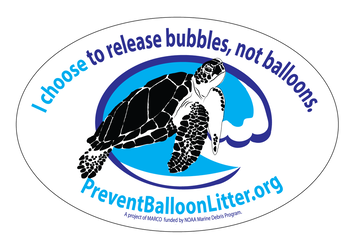
Virginia Social Marketing Work to Reduce Balloon Litter Expands throughout Mid-Atlantic
One of the actions identified in the first Virginia Marine Debris Reduction Plan in 2014 was a social marketing campaign to discourage people from releasing balloons. While all marine debris has some potential to harm wildlife, balloons have been identified as among the five deadliest types of debris due to the risk they pose to marine wildlife through ingestion and entanglement.
In 2015, the Virginia CZM Program received a grant from the NOAA Marine Debris Program to pursue this work, and partnered with CVW and OpinionWorks to conduct extensive, state-wide, research to better understand who plans balloon release events – and, most importantly, why. This research informed design of the Joyful Send-off campaign in Virginia, which targeted balloon releases held during weddings, and focused on alternatives to release.
Before expanding the Virginia campaign throughout the Mid-Atlantic, and with additional funding from the NOAA Marine Debris Program to the Mid-Atlantic Regional Council on the Ocean, the team conducted additional research across the region to validate our earlier findings. The Mid-Atlantic Prevent Balloon Litter Campaign focuses on a one-to-many, social normative strategy emphasizing the use of balloon release alternatives during celebratory, memorial and other events. Messaging stresses the ceremonial aspect of alternatives that create a lasting tribute and joyful, uplifting moments. A pilot campaign was launched in fall 2021 with the National Aquarium, New York Aquarium and Virginia Aquarium. The full campaign (including a Teacher Kit on the website, which offers many downloadable materials) continues through early spring 2023. See more on PreventBalloonLitter.org.
The Virginia CZM Program, established in 1986, is a network of state agencies and local governments led by DEQ that administer the enforceable laws and regulations that protect our air and water quality and coastal habitats. Read more about the coastal resiliency, restoration and conservation efforts of the Virginia CZM Program being funded through the CZMA. Visit https://www.deq.virginia.gov/coasts.
One of the actions identified in the first Virginia Marine Debris Reduction Plan in 2014 was a social marketing campaign to discourage people from releasing balloons. While all marine debris has some potential to harm wildlife, balloons have been identified as among the five deadliest types of debris due to the risk they pose to marine wildlife through ingestion and entanglement.
In 2015, the Virginia CZM Program received a grant from the NOAA Marine Debris Program to pursue this work, and partnered with CVW and OpinionWorks to conduct extensive, state-wide, research to better understand who plans balloon release events – and, most importantly, why. This research informed design of the Joyful Send-off campaign in Virginia, which targeted balloon releases held during weddings, and focused on alternatives to release.
Before expanding the Virginia campaign throughout the Mid-Atlantic, and with additional funding from the NOAA Marine Debris Program to the Mid-Atlantic Regional Council on the Ocean, the team conducted additional research across the region to validate our earlier findings. The Mid-Atlantic Prevent Balloon Litter Campaign focuses on a one-to-many, social normative strategy emphasizing the use of balloon release alternatives during celebratory, memorial and other events. Messaging stresses the ceremonial aspect of alternatives that create a lasting tribute and joyful, uplifting moments. A pilot campaign was launched in fall 2021 with the National Aquarium, New York Aquarium and Virginia Aquarium. The full campaign (including a Teacher Kit on the website, which offers many downloadable materials) continues through early spring 2023. See more on PreventBalloonLitter.org.
The Virginia CZM Program, established in 1986, is a network of state agencies and local governments led by DEQ that administer the enforceable laws and regulations that protect our air and water quality and coastal habitats. Read more about the coastal resiliency, restoration and conservation efforts of the Virginia CZM Program being funded through the CZMA. Visit https://www.deq.virginia.gov/coasts.
Wild Turkey Summer Brood Survey Results
By Katie Martin, Deer-Bear-Turkey Biologist and Mike Dye, Forest Game Bird Project Leader, Virginia Department of Wildlife Resources
Through the months of July and August, the Virginia Department of Wildlife Resources (DWR) staff and
cooperators completed the annual turkey brood survey. The survey provides an index to productivity of
wild turkey reproduction and can assist in making management decisions. The survey counts the
number of turkeys observed by staff and cooperators as they go about their normal day to day business
and is expressed as the number of turkeys observed per 1,000 miles driven and the number of poults
(juvenile turkey) observed per hen. The Department would like to thank the many volunteers of the
Virginia National Wild Turkey Federation chapters, DWR Complementary Work Force and Hunter
Education Instructors, and the Virginia Master Naturalists for their survey participation in 2022!
The 2022 annual survey suggests reproduction for wild turkey declined to a statewide average of 1.9
poults/hen, falling below the long term survey average of 2.5 poults/hen. The overall number of turkeys
staff have observed in the summer has declined since 2015. In 2022, the total number of turkeys
observed fell below the long-term average (18.4/1,000 miles) to 10.1 birds per 1,000 miles. Wild turkey
success in hatching and raising broods plays an important role in wild turkey populations and is
especially important in fall harvests. Further, the ratio of young birds (poults) to the number of females
(hens) is a critical index to reproduction (P/H).
See the attached Wild Turkey Summer Brood Survey Results PDF for more information and graphs of the data.
By Katie Martin, Deer-Bear-Turkey Biologist and Mike Dye, Forest Game Bird Project Leader, Virginia Department of Wildlife Resources
Through the months of July and August, the Virginia Department of Wildlife Resources (DWR) staff and
cooperators completed the annual turkey brood survey. The survey provides an index to productivity of
wild turkey reproduction and can assist in making management decisions. The survey counts the
number of turkeys observed by staff and cooperators as they go about their normal day to day business
and is expressed as the number of turkeys observed per 1,000 miles driven and the number of poults
(juvenile turkey) observed per hen. The Department would like to thank the many volunteers of the
Virginia National Wild Turkey Federation chapters, DWR Complementary Work Force and Hunter
Education Instructors, and the Virginia Master Naturalists for their survey participation in 2022!
The 2022 annual survey suggests reproduction for wild turkey declined to a statewide average of 1.9
poults/hen, falling below the long term survey average of 2.5 poults/hen. The overall number of turkeys
staff have observed in the summer has declined since 2015. In 2022, the total number of turkeys
observed fell below the long-term average (18.4/1,000 miles) to 10.1 birds per 1,000 miles. Wild turkey
success in hatching and raising broods plays an important role in wild turkey populations and is
especially important in fall harvests. Further, the ratio of young birds (poults) to the number of females
(hens) is a critical index to reproduction (P/H).
See the attached Wild Turkey Summer Brood Survey Results PDF for more information and graphs of the data.
Special Guest Presentation: One Ocean. One Canoe. One People
Contributed by Dr. Kirk Havens, Director, Center for Coastal Resources Management, Virginia Institute of Marine Science
Wednesday, November 16, 7-8:30 pm
In person at Watermen's Hall
VIMS, Gloucester Point
Prepare to be inspired and captivated by native Hawaiian navigator Nainoa Thompson during this very special presentation at VIMS. Thompson has dedicated his life to exploring the deep meaning of voyaging, inspired by mentors who introduced him to the mysteries of the inshore ocean, the stars his ancestors used to navigate great distances, the natural signs that provide guidance, and the universal values of voyaging: vision, self-discipline, preparation, courage, risk-taking, and the spirit of aloha.
On long voyages, under a dome of stars and surrounded by the vast ocean, Thompson came to appreciate the Hawaiian concept of "mālama" - care taking - from a planetary perspective. He will share that perspective while inspiring and educating us all to meet the challenges of a rapidly changing world with a melding of science and indigenous wisdom.
Thompson is president of the Polynesian Voyaging Society and VIMS' first Scholar in Ocean Residency. He is known around the world as a leader in the traditional Polynesian art of non-instrumented navigation and for his canoe voyages throughout the global ocean guided only by stars, waves, winds, and marine life. He has received numerous awards, including the Unsung Hero of Compassion, the NOAA National Marine Sanctuary Foundation Lifetime Achievement Award, the BLUE Ocean Film Festival Legacy Award, the National Geographic Society's Hubbard Medal, and the Explorers Club Medal.
Seating for this program is limited, so early registration is strongly encouraged. A brief reception will be held afterward with Thompson and Lehua Kamalu, the first woman to serve as lead captain and lead navigator of the Hokule'a, a double-hulled voyaging canoe, on a traditional ocean crossing. Register here for the in-person event. You may also register here to participate in this event online.
Contributed by Dr. Kirk Havens, Director, Center for Coastal Resources Management, Virginia Institute of Marine Science
Wednesday, November 16, 7-8:30 pm
In person at Watermen's Hall
VIMS, Gloucester Point
Prepare to be inspired and captivated by native Hawaiian navigator Nainoa Thompson during this very special presentation at VIMS. Thompson has dedicated his life to exploring the deep meaning of voyaging, inspired by mentors who introduced him to the mysteries of the inshore ocean, the stars his ancestors used to navigate great distances, the natural signs that provide guidance, and the universal values of voyaging: vision, self-discipline, preparation, courage, risk-taking, and the spirit of aloha.
On long voyages, under a dome of stars and surrounded by the vast ocean, Thompson came to appreciate the Hawaiian concept of "mālama" - care taking - from a planetary perspective. He will share that perspective while inspiring and educating us all to meet the challenges of a rapidly changing world with a melding of science and indigenous wisdom.
Thompson is president of the Polynesian Voyaging Society and VIMS' first Scholar in Ocean Residency. He is known around the world as a leader in the traditional Polynesian art of non-instrumented navigation and for his canoe voyages throughout the global ocean guided only by stars, waves, winds, and marine life. He has received numerous awards, including the Unsung Hero of Compassion, the NOAA National Marine Sanctuary Foundation Lifetime Achievement Award, the BLUE Ocean Film Festival Legacy Award, the National Geographic Society's Hubbard Medal, and the Explorers Club Medal.
Seating for this program is limited, so early registration is strongly encouraged. A brief reception will be held afterward with Thompson and Lehua Kamalu, the first woman to serve as lead captain and lead navigator of the Hokule'a, a double-hulled voyaging canoe, on a traditional ocean crossing. Register here for the in-person event. You may also register here to participate in this event online.

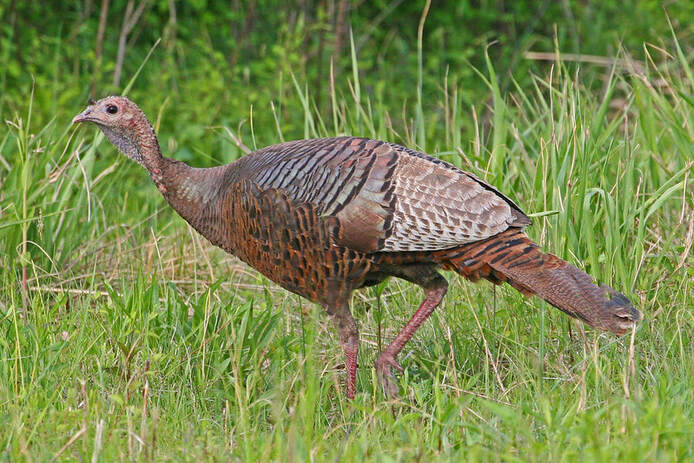
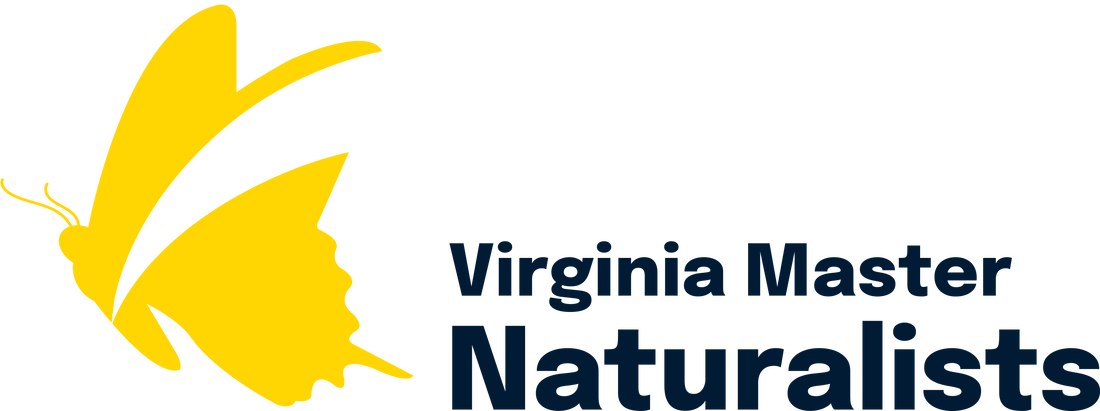
 RSS Feed
RSS Feed